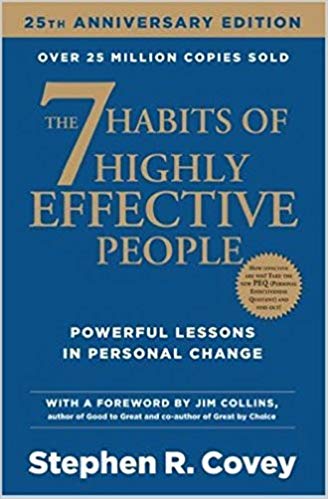

This article is an excerpt from the Shortform summary of "The 7 Habits of Highly Effective People" by Stephen Covey. Shortform has the world's best summaries of books you should be reading.
Like this article? Sign up for a free trial here .
What are “Private Victories”? What is the purpose of Stephen Covey’s first three habits?
Covey’s first three habits of highly effective people are collectively called “Private Victories.” These habits lay the foundation for “Public Victories” (habits four to six, which improve interactions with others) by strengthening your personal character and developing independence.
Read on to learn about Covey’s three Private Victory habits: 1) be proactive, 2) start with the end in mind, and 3) prioritize the important over the urgent.
Private Victories
In his book The 7 Habits of Highly Effective People, Stephen Covey provides an inside-out approach to improving yourself and your life by developing seven habits.
The 7 Habits are designed to build from the foundation up—or the inside out—to establish a mindset, habits, and skills that help you identify and achieve the things that are most important to you. You don’t need to perfect each habit before moving onto the next; as you progress and grow, you will naturally continue to improve in all the previous habits. This is not a quick-fix program that you work through once and move on, it’s an ongoing process of personal growth and change.
Habits 1-3 develop independence through “Private Victories.” This stage focuses on building your independence and laying the foundation for Habits 4-6 (“Public Victories”) and Habit 7 (Self-Renewal).
Habit 1: Be Proactive
In every situation, you have the choice of being reactive or proactive. If you’re reactive, you let your habits and conditioning dictate how you respond to the people and circumstances around you; if you’re proactive, you decide how you’ll respond to create the results you want. Being proactive requires you to take responsibility for your actions and their consequences, but it also empowers you to take hold of your life and make significant changes to your mindset and behavior.
| Proactivity Doesn’t Guarantee Results When it comes to your Circle of Influence, Covey makes an important, implicit distinction between the things you can affect and the things you can control. By his definition, you move a concern into your Circle of Influence by coming up with a plan to address it, though there’s no way to guarantee the outcome. This suggests that proactivity’s greater virtue is in the psychological relief of tackling an issue and putting it to bed, rather than the actual results of the action. For instance, a proactive person can influence their daughter’s grades by helping her study and working with her to create a schedule. However, they can’t force their daughter to focus or stick to the schedule. Ultimately, there is no way to control their daughter’s behavior or performance in school, but a proactive person is still motivated to take the steps available to influence the situation. |
Habit 2: Start With the End in Mind
To achieve the life you want, create a personal mission statement to identify the big picture—the life you want to lead, the character traits you want to embody, the impact you want to have on those around you. This document serves as a reminder of your ultimate goals and helps you ensure each short-term pursuit and daily action is in line with what’s most important to you.
| Checklist for Creating Your Personal Mission Statement Habit 2 explains how you can develop a personal mission statement as a first step toward creating your own destiny. Follow these steps to practice some of the techniques discussed in Habit 2. 1) Imagine yourself at the funeral of a loved one. Visualize the scene, see your friends and family filing in as they grieve. Picture yourself approaching the casket, and when you get there you discover it’s your funeral. Imagine what your family members, your coworkers, and your friends will say about you and your life. Write down what you would want them to say about the person you are and the life you lead. 2) Think of a project you’ll begin working on soon. Before you start it, make your first creation of the project — write down what you want the final product to be, and what steps you’ll need to make to achieve that. 3) Write down the roles you have in your life. 4) Review the different centers discussed earlier (principle, spouse, family, money, etc.) and circle all that you identify with. Think about your life and how these values impact your decisions and actions. Are you satisfied with your centers and their influence on your life? 4) Start a habit of jotting down notes, ideas, and quotes that you might want to use in your personal mission statement. 5) Set aside time in your schedule to work on your personal mission statement. 6) Explain the principles of Habit 2 with your family or work team, and work on developing a group mission statement. Be sure to involve everyone in the process, and allow people to share their thoughts and priorities as you develop a final product that everyone feels committed to and invested in. |
Habit 3: Prioritize Important Over Urgent
Habit 3 zooms in to daily and weekly time management so that you stay focused on your goals and values despite any demands and curveballs life throws at you. To effectively manage your time and improve your life, you must develop a keen sense of what’s truly important — what aligns with your personal mission statement — and prioritize time for those tasks, even when it means saying “no” to appealing but unimportant activities. To identify which activities are important, consult Covey’s four-quadrant time management framework.
| Urgent | Not Urgent | |
| Important | Quadrant IUrgent and Important | Quadrant IINot Urgent, but Important |
| Not Important | Quadrant IIIUrgent but Not Important | Quadrant IVNeither Urgent nor Important |
Quadrant I is urgent and important. Crises and problems live here, and life inevitably throws some Quadrant I tasks at all of us. However, some people seem to spend all their time in Quadrant I, constantly putting out fires and feeling like they never have time or energy to tackle anything that’s not urgent; in need of respite, they occasionally escape to the more leisurely Quadrant IV, where things are neither urgent nor important. The catch is that the more time you spend in Quadrant I, the more you will be stuck there, because you don’t have time to do the maintenance and preventive measures that help avoid crises.
Quadrant III is urgent, but not important. These kinds of activities can eat up your precious time and energy, without giving much value back to your life. Some people don’t even realize that these matters are not important, assuming that urgency implies importance; but the urgency is often dictated by other people’s priorities and expectations — what other people tell you must get done — rather than your own goals and values.
Quadrant IV is neither urgent nor important. These are things you may do purely for enjoyment, or out of confusion about what’s truly important. Quadrants III and IV are irresponsible uses of your time, because they contribute nothing toward your life, and effective people tend to avoid these activities.
Quadrant II is not urgent, but important. This is where effective people focus their time and energy, and the discipline to prioritize these tasks is key to self-management and achieving your personal mission. Quadrant II includes activities that could easily be put off for their lack of apparent urgency, but which will greatly benefit your life in the long term if you invest the time in them; they include developing relationships, defining your personal mission statement, exercising, and performing preventive maintenance (e.g. oil changes for your car, health check-ups, flossing, or home maintenance).
Effective people are proactive and understand the value of investing their time and energy into Quadrant II activities. Effective people respond to opportunities to do what’s important, instead of reacting to urgent problems. When things come up, it’s easier to determine what’s important and what isn’t once you’ve defined your goals and personal mission statement.
———End of Preview———

Like what you just read? Read the rest of the world's best summary of "The 7 Habits of Highly Effective People" at Shortform . Learn the book's critical concepts in 20 minutes or less .
Here's what you'll find in our full The 7 Habits of Highly Effective People summary :
- How to prioritize the hundred tasks you have to focus on the one or two that really matter
- The right way to resolve every disagreement and argument
- How to avoid burning out and succeed over 20+ years






